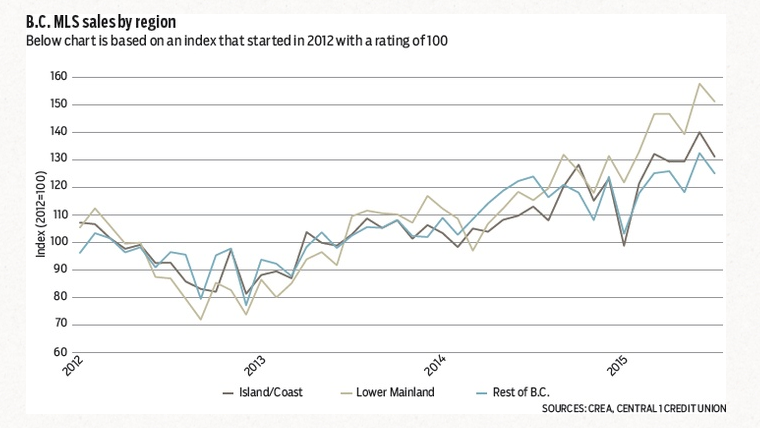
A slew of housing data this week points to persistent strength in B.C.’s housing market as low interest rates, population gains and modest economic growth continued to drive elevated activity in July.
Robust housing market activity aligns with our expectations that the sector will be a key growth driver for B.C.’s economy both this year and next.
B.C. sales on the Multiple Listing Service (MLS) held steady in July at a seasonally adjusted 8,500 units. While marking a near-identical pace to the previous two months, sales are trending at a level in line with the mid-2000s and are up 20% from the same month in 2014. However, stable provincial sales activity in July masked some regional variation.
Sales climbed slightly in the Lower Mainland-Southwest and held steady in Victoria.
In contrast, offsetting declines occurred elsewhere in the province. This points to strong housing demand in larger urban centres amid low interest rates and economic expansion. In contrast, other markets are exhibiting some strain from tempered commodity market activity, lower demand from secondary home buyers from Alberta and local resource workers who have lost their jobs in the Athabasca oilsands.
Additionally, wildfires may have contributed to lower sales in some regions.
Housing sales have broadly outpaced growth in new home listings across the province, leading to downward momentum in inventories. Metro Vancouver in particular is facing a supply-side crisis as inventory dwindles to the lowest level since late 2006. Sales-to-active-listing ratios are favouring sellers in the Lower Mainland and on Vancouver Island. Markets are generally balanced elsewhere in the province with the exception of the Kootenay and northeast B.C.
While the average provincial home value slipped from June by 0.8% to a seasonally adjusted $628,040, solid market conditions are putting upward pressure on prices, pushing the year-over-year gain to 11%.
However, most of this reflects accelerated price growth in the Lower Mainland and a higher share of sales this year in the higher-priced Lower Mainland and Victoria markets. In contrast, average price growth in other markets has been mild in the 2% to 4% range.
An alternative and superior metric for price is the MLS’s constant-quality housing price index, but that index is available only for Lower Mainland and Vancouver Island markets.
The underlying price growth in the Lower Mainland is up an aggressive 9% year-over-year due to exceptionally high demand for single-family homes. Vancouver Island markets are showing more modest year-over-year gains of about 4%. •
Bryan Yu is senior economist at Central 1 Credit Union.
Reference: https://www.biv.com/article/2015/8/low-interest-rates-keep-bc-housing-market-buoyant/?utm_source=BIV+Newsletters&utm_campaign=24c5ac2caa-Weekly_Real_Estate_August_26_20158_26_2015&utm_medium=email&utm_term=0_6d3015fdef-24c5ac2caa-210798317


